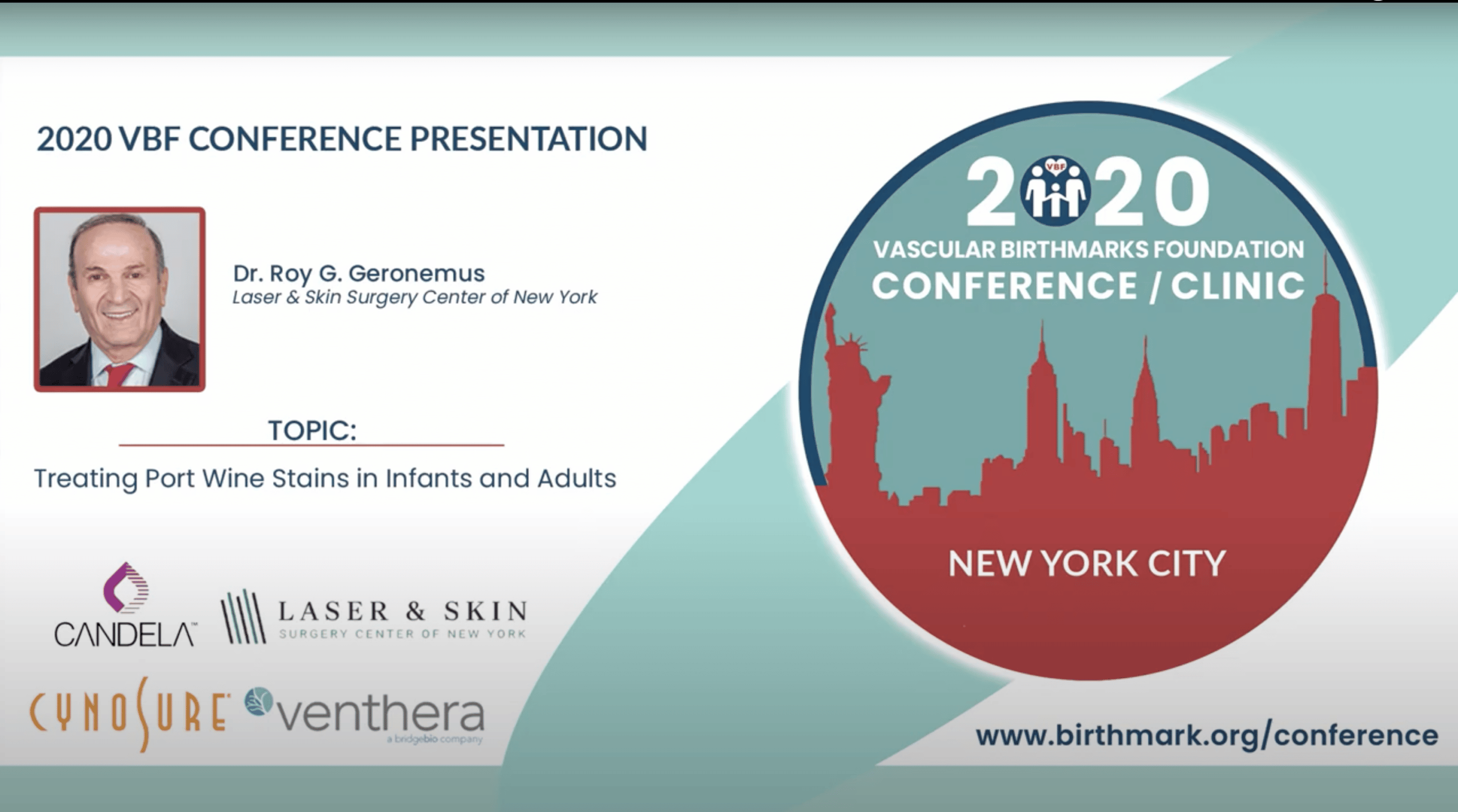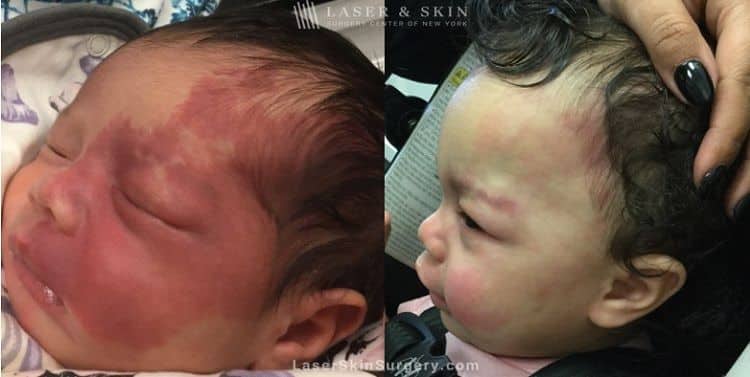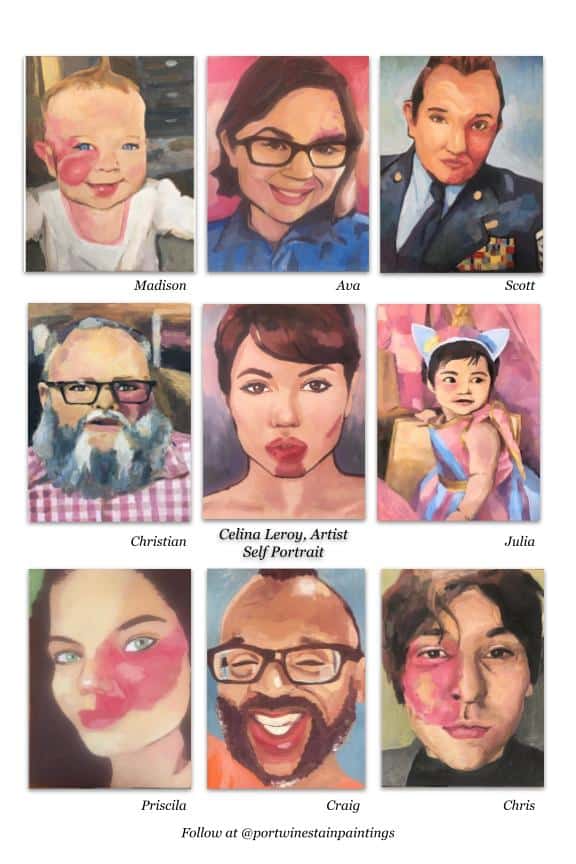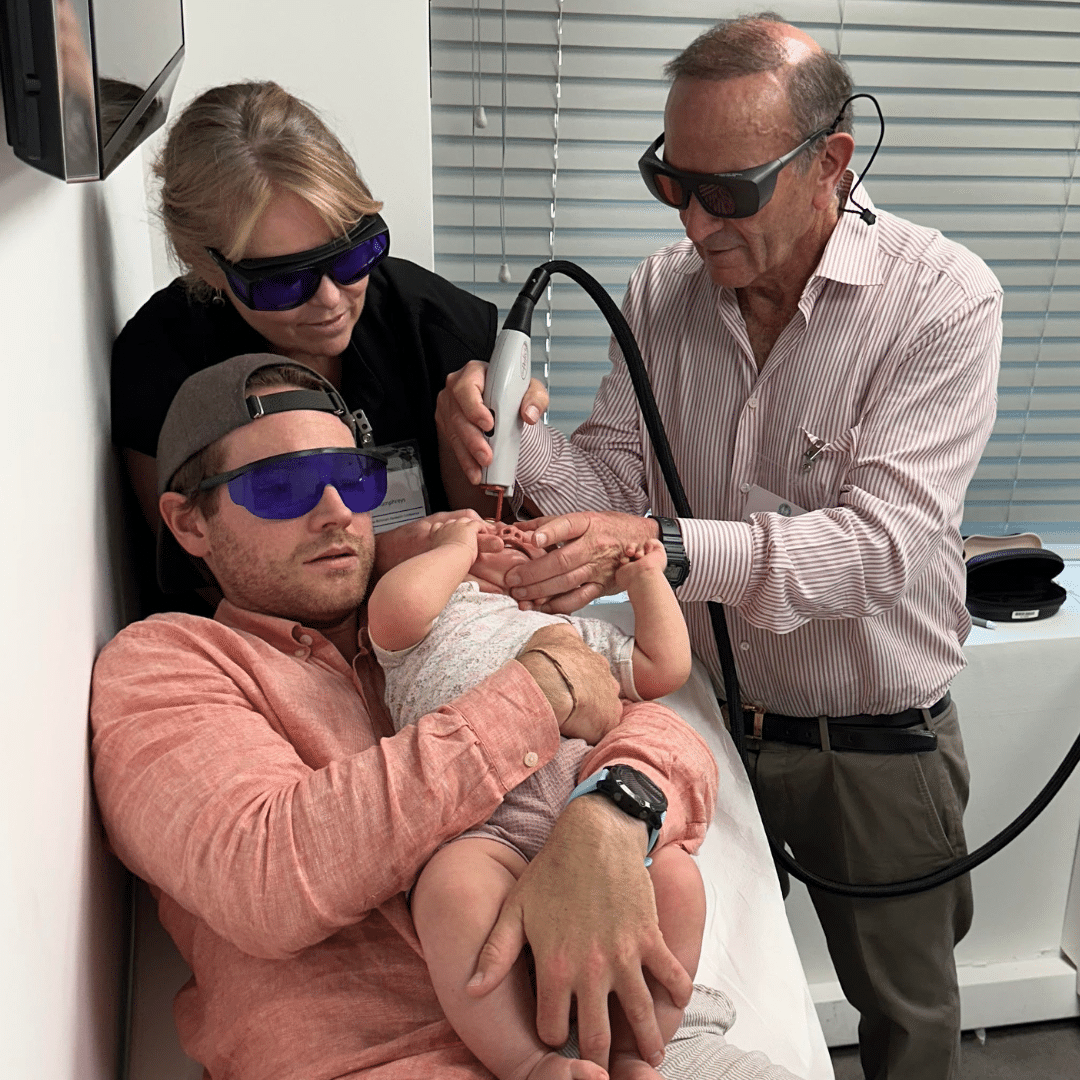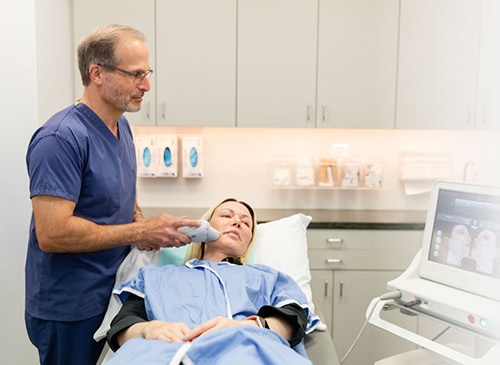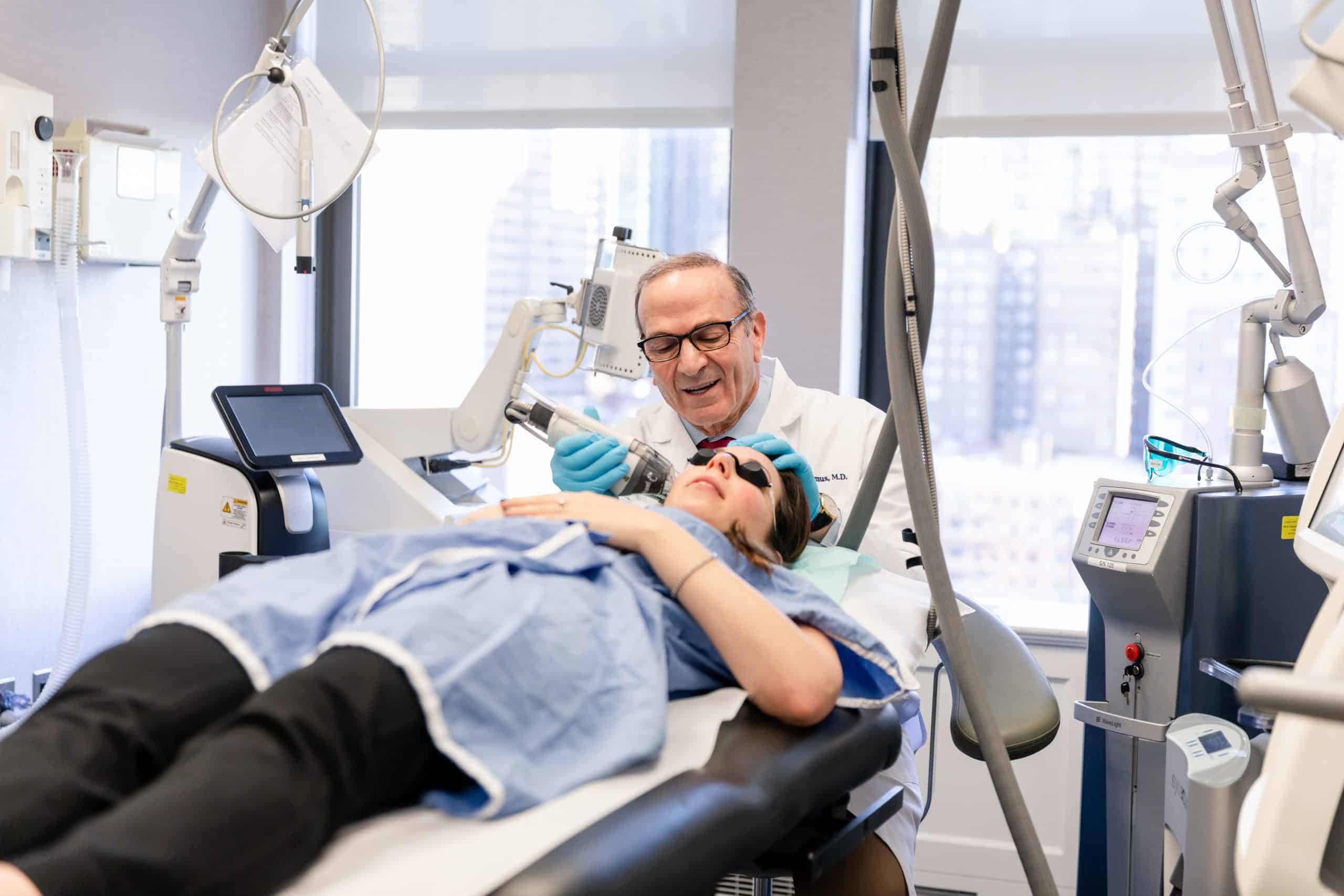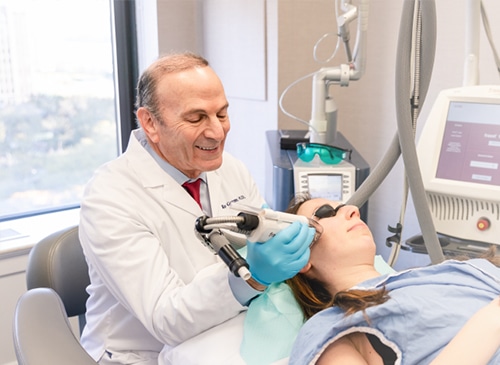Homepage // Conditions / Port Wine Stains
Port Wine
Stains
Port-wine stains are a type of birthmark in which dilated capillaries are under the skin, resulting in a large red or pink mark. The physicians at Laser & Skin Surgery Center of New York are experts at treating port-wine stains in patients of all ages, including infants. We see patients from around the world because of our expertise and experience in this area.
port wine stains
What Are The Qualifications of the Physicians at the Laser & Skin Surgery Center of New York?
The physicians at the Laser & Skin Surgery Center of New York are world experts in the area of port-wine stain treatments. We see patients across the country and around the globe who seek our experience and expertise to treat even the more challenging markings. We have participated in numerous studies and published multiple articles on this subject to help other practitioners treat their patients effectively. Recently, our own Dr. Geronemus conducted a groundbreaking study on PWB in infants. His findings revealed that once-weekly pulsed dye laser (PDL) treatments led to either near-total (76%-95% clearance) or total clearance (96%-100%) of the birthmarks in 70% of the infants after just 2 months, suggesting that more frequent treatments can significantly improve outcomes quickly and safely. Our center specializes in the outpatient management of patients with this condition and services can also be provided at the New York Eye & Ear Infirmary for those patients requiring general anesthesia.
We offer a dedicated portion of our practice to treating patients of all ages with port-wine stains, including infants and toddlers. Our office is designed with families and young children in mind, making all of our patients feel comfortable and welcome. Dr. Geronemus believes early intervention through quick, painless in-office treatments offers a superior outcome. He is a board member of the Vascular Birthmark Association and works with families and other doctors to address vascular birthmarks and tumors. His commitment continues through his Dr. Roy G. Geronemus Humanitarian Scholarship.
What are Port Wine Stains?
Port-wine stains are blue, pink, or red markings on the skin that are frequently present at birth. Most of these birthmarks do not pose a serious medical concern, although they can occasionally be an indication of an underlying condition. People who are self-conscious about a port-wine stain can usually have it removed for cosmetic reasons.
Port-wine stains occur when capillaries in the area dilate too much. Capillaries are very small blood vessels, but when blood collects inside of them, it can result in a distinct discoloration on the surface of the skin. Many port-wine stains start out looking pink, but the color can deepen to a reddish-purple hue over time.
Most port-wine stains occur on the face, scalp, neck, arms, and legs. However, the markings can occur anywhere on the body. Most of these stains are not a significant medical concern, although they can be an indication of a serious medical condition in rare instances. However, parents of children with port-wine stains may seek treatment for cosmetic reasons, just as adults with the birthmarks often pursue treatment to reduce or eliminate them. Patients born with port-wine stains should get treated as early as possible. A case study suggests that delay in treating port-wine stains can make it difficult to remove as it progresses with age.
One of our very own patients painted these beautiful portraits of people with port-wine stains. You can follow her work on Instagram.
After our last visit, I have been giving thought to our conversation regarding the opposition you receive treating patients such as my daughter. We have been coming to see you for a few years, and my husband and I talk on an almost daily basis about how this is the best gift we could have given our little girl. Traveling with a 13 month old during the pandemic, the National Guard checking us into LaGuardia, was not an easy process. However, you and your team have changed our little girl’s life, and ours. We are tremendously and eternally grateful and continue to be. When we started with you treatments had been once every 8 weeks with no bruising (and no observable change).
After about 5 treatments, we were told they could not do much more – and luckily, we found you. Your care, skill and approach has been life changing. I had dreamed that my little lady would be able to make her own decisions one day whether or not she would wear makeup or not – depending on her confidence level. You have allowed this to happen! I am attaching photos from birth and now and the difference is astonishing. This is what we dreamed of for her – thank you is not enough. She is a happy, confident, silly, smart, adorable and wonderful little person. I will try to get a video of her saying that your treatment tickles her and send, too.
What does a typical treatment look like?
Treatments are usually performed in the office setting with either no anesthesia, topical anesthesia or local anesthesia. We begin treatment in early infancy to facilitate the optimum response and outcome. Typically, multiple treatments are required and a complete cure is not always possible. Treatment intervals will vary based upon the variety of factors including the diagnosis, location of the birthmark, and the age of the patient.
There are several lasers available for port wine stain treatment. The most commonly used is the pulsed dye laser (Vbeam Perfecta and Vbeam Prima). Broadband light therapy (BBL) is another option. We also use the Excel V laser for thicker port wine stains in older patients. The choice of laser is based on the characteristics of the birthmark.
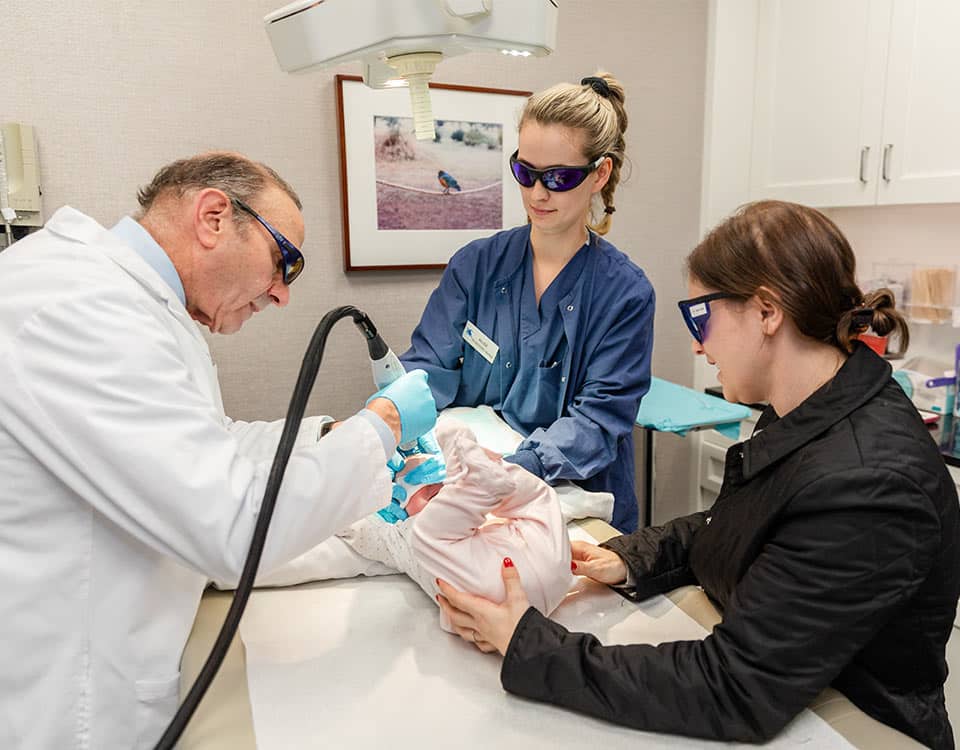
HOW DO LASERS WORK IN TREATING PORT WINE STAINS
Due to the wavelength that the laser operates at, the pulsed dye laser is able to effectively treat the affected area without harming the surrounding skin. This is demonstrated in the following video where Dr. Roy G. Geronemus is able to pop the red balloon with the laser without affecting the white balloon.
PUBLICATIONS
“Weekly Pulsed Dye Laser Treatments for Port-Wine Birthmarks in Infants.”
JAMA Dermatol. 2024 Apr 17.
“Consensus Statement for the Management and Treatment of Port-Wine Birthmarks in Sturge-Weber Syndrome.”
JAMA Dermatol. 2020 Nov 11
“Assessment of Treatment Tolerance and Parental Perspective of Outpatient Pulsed-Dye Laser Treatment for Port-Wine Birthmark without General Anesthesia in Infants and Toddlers” Journal of the American Academy of Dermatology 2020 September 30
“Case Series of Corneal Eye Shield Application for Laser Treatment of Periocular Port-Wine Stains in Infancy.”
J Am Acad Dermatol. 2020 Jul 29
“Treating port-wine stain birthmarks using dynamic optical coherence tomography-guided settings.” J Am Acad Dermatol. 2019 Aug 1
“Avoiding General Anesthesia in Treating Port-Wine Stains in Infants to Avoid Neurotoxic Events-Reply.” JAMA Dermatology, 2019 July 3
“Pulsed Dye Laser Treatment of Port-Wine Stains in Infancy Without the Need for General Anesthesia.” JAMA Dermatology, 2019 April 1
“Pulsed Dye Laser at Subpurpuric Settings for the Treatment of Pulsed Dye Laser-Induced Ecchymoses in Patients With Port-Wine Stains.” Dermatologic Surgery, 2018 Feb.
“The effect of general anesthesia on Neurodevelopment Abnormalities in children undergoing treatment of vascular anomalies with laser surgery: a retrospective review” Dermatol Surg. 2017 Apr;43(4):534-540
“Treatment of recalcitrant port-wine stains (PWS) using a combined pulsed dye laser (PDL) and radiofrequency (RF) energy device.” J Am Acad Dermatol. 2017 Feb;76(2):321-326. doi: 10.1016/j.jaad.2016.03.004.
“Effect of General Anesthesia on Neurodevelopmental Abnormalities in Children Undergoing Treatment of Vascular Anomalies With Laser Surgery: A Retrospective Review.” Dermatol Surg. 2016 Dec 26
“Successful treatment of two pediatric port wine stains in darker skin types using 595 nm laser.” Lasers Surg Med. 2016 Jan 8
“Laser treatment of port-wine stains.” Clin Cosmet Investig Dermatol. 2015 Jan 12;8:27-33.
“Treatment of Port-Wine Stains With a Short Pulse Width 532-nm Nd: YAG laser.” J Drugs Dermatol. 2013 Jan 1:12(1):66-71.
“High fluence modified pulsed dye laser photocoagulation with dynamic cooling of port wine stains in infancy.” Arch Dermatol 136:942-943, 2000.
“Stress and family satisfaction in parents of children with facial port wine stains.” Ped Dermatol 16(3):190-197, 1999.
“Treatment of port wine stains.” N Engl J Med 339:635-636, 1998.
“Effect of dynamic cooling on 585 nm pulsed dye laser treatment of port-wine stain birthmarks.” Dermatol Surg 23:657-662, 1997.
“Effect of 7 mm vs. 5 mm spot size on pulsed dye laser treatment of port-wine stains and hemangiomas.” Lasers Surg Med 7:56, 1995.
“Pulsed dye laser therapy of resistant port-wine stains.” Dermatol Surg 21:515-521, 1995.
“Anatomical differences of port-wine stains located on the trunk and extremities in response to treatment with the pulsed dye laser” (abstr.) Laser Surg Med 14(suppl 6):47, 1994.
“Anatomical differences in the treatment of port wine stains with the pulsed dye laser.” Arch Dermatol 129:182-188, 1993.
“Treatment of peri-orbital port wine stains utilizing the flashlamp-pumped pulsed dye laser.” Arch Ophthal 110:793-797, 1992.
“Treatment of a port wine stain in a black patient with the pulsed dye laser.” J Derm Surg Oncol 18:147-148, 1992.
“Flashlamp-pumped pulsed dye laser for port wine stains in infancy: Earlier versus later treatment.” J Am Acad Dermatol 24:467-472, 1991.
“The medical necessity of the evaluation and treatment of port wine stains.” J Derm Surg Oncol 17:76-79, 1991.
“Treatment of port wine stains during childhood with the flashlamp-pumped pulsed dye laser.” J Am Acad Dermatol 23:1142-1148, 1990.
“The use of the pulsed dye laser for the treatment of port-wine stains in children.” N Engl J Med 321:901-902, 1989.
Real Patients Before and After photos
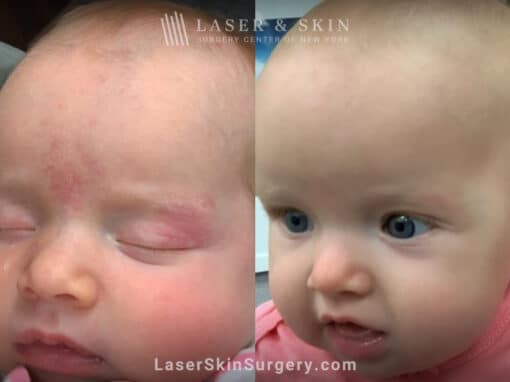
Port wine stain removal from baby’s face
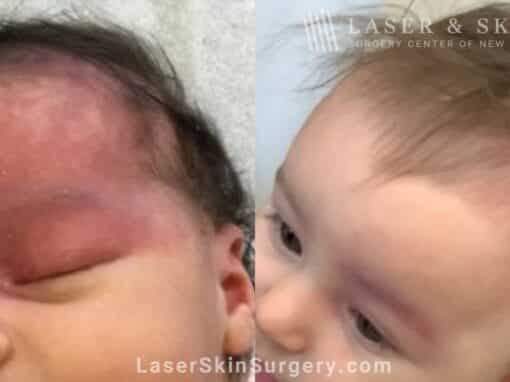
Vbeam laser to treat port wine birthmark on infant’s eye and forehead
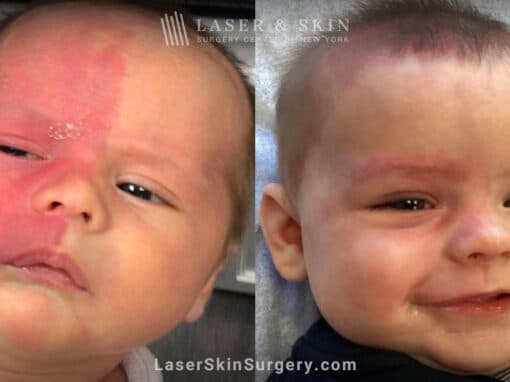
Vbeam prima laser to treat port wine birthmark on infant’s face
Port-Wine Stains In The News

Weekly Pulsed Dye Laser Treatments for Port-Wine Birthmarks in Infants
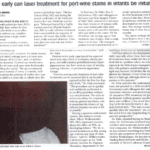
How early can laser treatment for port-wine stains in infants be initiated?
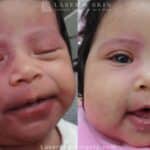
How Early Can Laser Treatment For Port Wine Stains in Infants Be Initiated?, featuring Dr. Geronemus

Laser & Skin Surgery Center of New York hosting 2020 VBF Vascular Birthmark/Anomalies Conference and Clinic on December 12
port wine stains
Questions and Answers
Q: How Effective is Laser Treatment?
A: The data from the treatment of port-wine stains is variable in terms of the clinical response. Recent published studies have shown an improvement ranging anywhere from 75 – 100% following a series of treatment sessions. More recently, improved technology and treatment protocols have allowed for a tendency towards more lightening and clearing of port-wine stains. A recent study from our Center revealed close to 90% clearing when treatment begins in infancy.
Q: When Should Treatment Begin?
A: Treatment protocols and choice of technology may vary from physician to physician. Early intervention makes a significant difference. It’s preferred to initiate treatment during early infancy with treatment parameters that approximate those given to adults at relatively short intervals of two to four weeks. This “window of opportunity” during infancy allows for more complete clearing than is seen with older patients in all anatomical sites. Treatments have begun as early as several days of age.
Our 2019 publication in JAMA Dermatology on the treatment of port-wine stains in infants confirmed the value of early intervention. Read Publication.
Q: How is Treatment During Infancy Handled?
A: Dr. Geronemus and the physicians at the Laser & Skin Surgery Center of New York have pioneered the treatment of infants with port-wine stains. We believe that early intervention will lead to a faster and more complete response to treatment while minimizing the requirements for anesthesia. While we offer all options for anesthesia, treatment during infancy can usually be performed without the need for anesthesia and is well tolerated by the babies. Our physicians are experts at the placement of protective ocular shields in the office setting, allowing for the treatment of the upper and lower eyelids during infancy.
Q: Do All Areas Respond The Same to Treatment?
A: There are some areas that are more difficult to treat than others. Typically, the central portion of the face and the lower arms, hands, lower legs and feet are much more resistant to therapy than other anatomical sites.
Q: What Does the Skin Look Like After Treatment?
A: In almost all cases there is bruising following each treatment session that will last for approximately seven to fourteen days. The risks from these laser treatments are small. Textural and pigmentary changes following treatment are not common.
Q: What Are The Options for Anesthesia or Pain Control?
A: We are often asked by parents and patients to comment on the choices for anesthetics for port wine stain treatment. For young infants, we typically will not give topical or general anesthesia unless we are dealing with a very large area. We defer the use of topical anesthesia until the child is one or two years of age, depending upon the choice of topical anesthetic. We sometimes use general anesthesia on a same-day surgery basis for those children who are uncooperative in the office setting or have large birthmarks that require a significant amount of time. In adults, topical anesthesia is usually sufficient to achieve a comfortable treatment.
For those patients who require intravenous sedation or general anesthesia, a comparable technology is available for use by our physicians at the New York Eye & Ear Infirmary.
Q: I Am Interested in Traveling to NY for Treatment. How Do I Make Arrangements?
A: Many of our patients and their families travel to our center for treatment from across the country and internationally. You may call the office for an appointment or series of appointments. Our staff can be of help with supporting documentation required for entry into the US or with insurance issues.
Q: Are There Support Groups Available for Patients with Birthmarks?
A: Children and adults undergoing laser treatment of their port-wine stains often require significant support from their family and friends as this is a long process that usually leads to significant physical and psychological benefits.
(Birthmark Groups)
Q: May I Wear Make-up Following the Procedure?
A: Make-up may be worn if there is no blistering or crusting following the procedure. Particular care must be taken to avoid irritation of the skin while removing the make-up. You should avoid abrasive or irritating make-up removers.
Q: May I Be Exposed To The Sun Following The Procedure?
A: Direct exposure of sunlight should be avoided following pulsed dye laser therapy. If there is no crusting or blistering, a sunscreen of SPF-15 or higher should be applied to the treated area for two months following the treatment to avoid sun damage.
Q: When Do I Return To Have My Treated Area Evaluated?
A: You should be checked within four to six weeks to evaluate the effectiveness of the laser treatment.
Next, read about…
Sagging Skin
The skin’s underlying structure degrades over time, leading to skin laxity and sagging skin. Collagen, the essential protein in our skin, begins to decline as early as our 20s, leaving skin without support from within. Restoring collagen helps to restore the skin’s youthful vitality.
Wrinkles
Wrinkles are a common and unwanted sign of aging. As you age, your body produces less collagen, creating saggy and wrinkly looking skin. Our customized strategies to combat wrinkles include laser resurfacing, dermal fillers, and wrinkle relaxers.
Brown age spots
Age spots and brown spots (also known as sunspots, liver spots, and lentigines) are a consequence of aging and sun exposure. The most effective treatment for eliminating these spots and other skin pigmentation is laser therapy, which usually includes little to no downtime after treatment.
Haven't found
WHAT you are looking for?
patient approved
Trusted Worldwide
patient approved
Trusted Worldwide
laser & skin surgery
center of new york
Contact us
Manhattan:
317 East 34th Street New York, NY 10016
Monday – Friday: 8:00am – 5:00pm
Saturday & Sunday: September through June by appointment only
Same-Day Appointments Now Available
Southampton:
325 Meeting House Lane, Bldg. 1, Ste. C Southampton, NY 11968
Monday - Wednesday, Friday: 9am - 4:30pm
Thursday: 9am - 5pm
Saturday October 1, 2022: By Appointment Only
Same-Day Appointments Now Available
Pay Online for Patients of Drs. Geronemus, Anolik, Bae & Seidenberg
Pay Online for Patients of Drs. Abraham, Bernstein, Krant, Shelton, Stern, Weiss, Hoffman, Shim, Murphy-Rose, Wilson, and Petratos
By LASER & SKIN SURGERY CENTER OF NEW YORK® | © 2024 All Rights Reserved. Design & Development by Goldman Marketing Group | Sitemap | Privacy Policy | The information available on this web site is provided for informational purposes only. This information is not intended to replace a medical consultation where a physician's judgment may advise you about specific disorders, conditions and or treatment options. We hope the information will be useful for you to become more educated about your health care decisions. If you are vision-impaired or have some other impairment covered by the Americans with Disabilities Act or a similar law, and you wish to discuss potential accommodations related to using this website, please contact us at (212) 941-5055.
*MDs perform 100% of all medical and cosmetic treatments.
